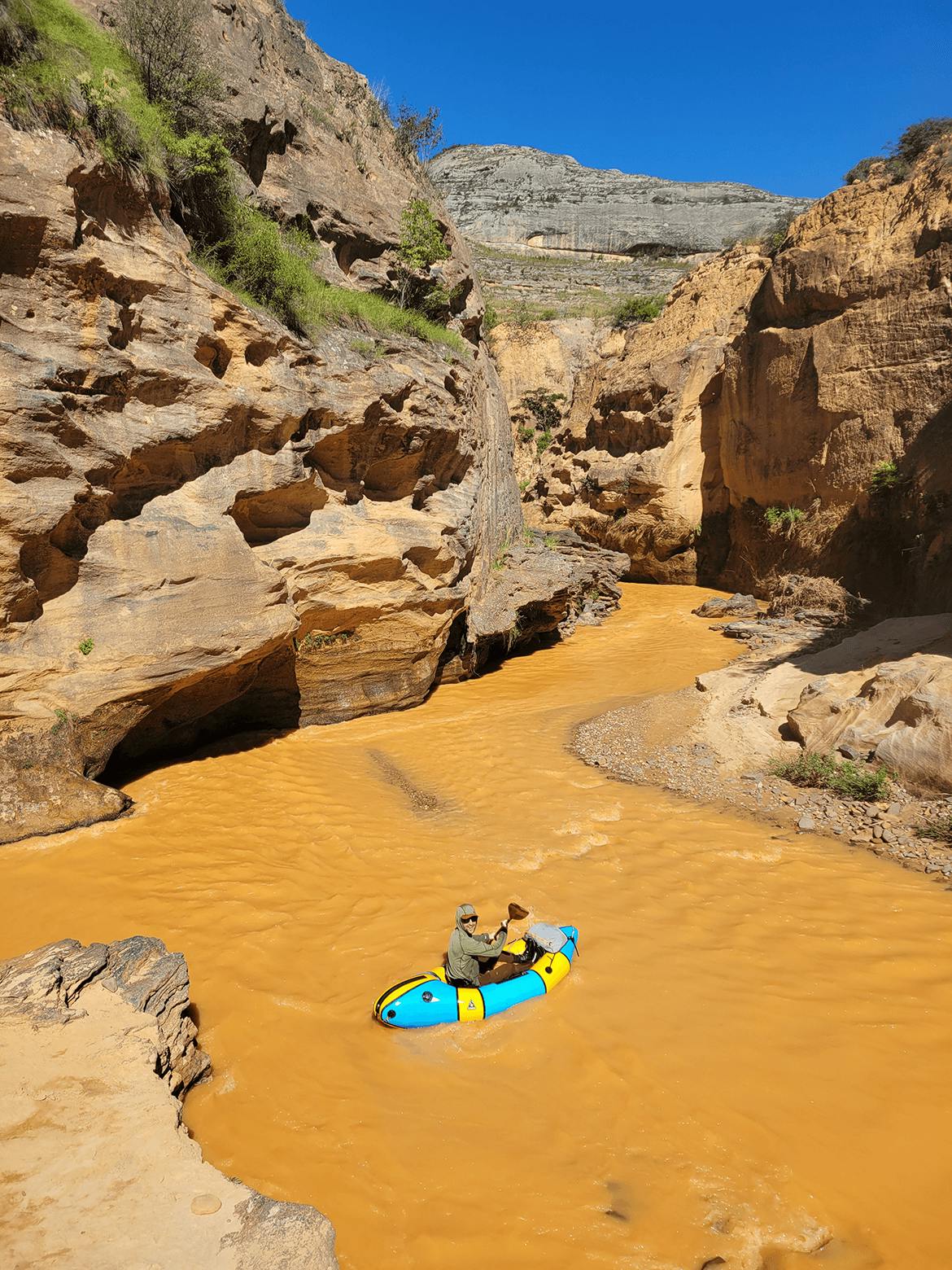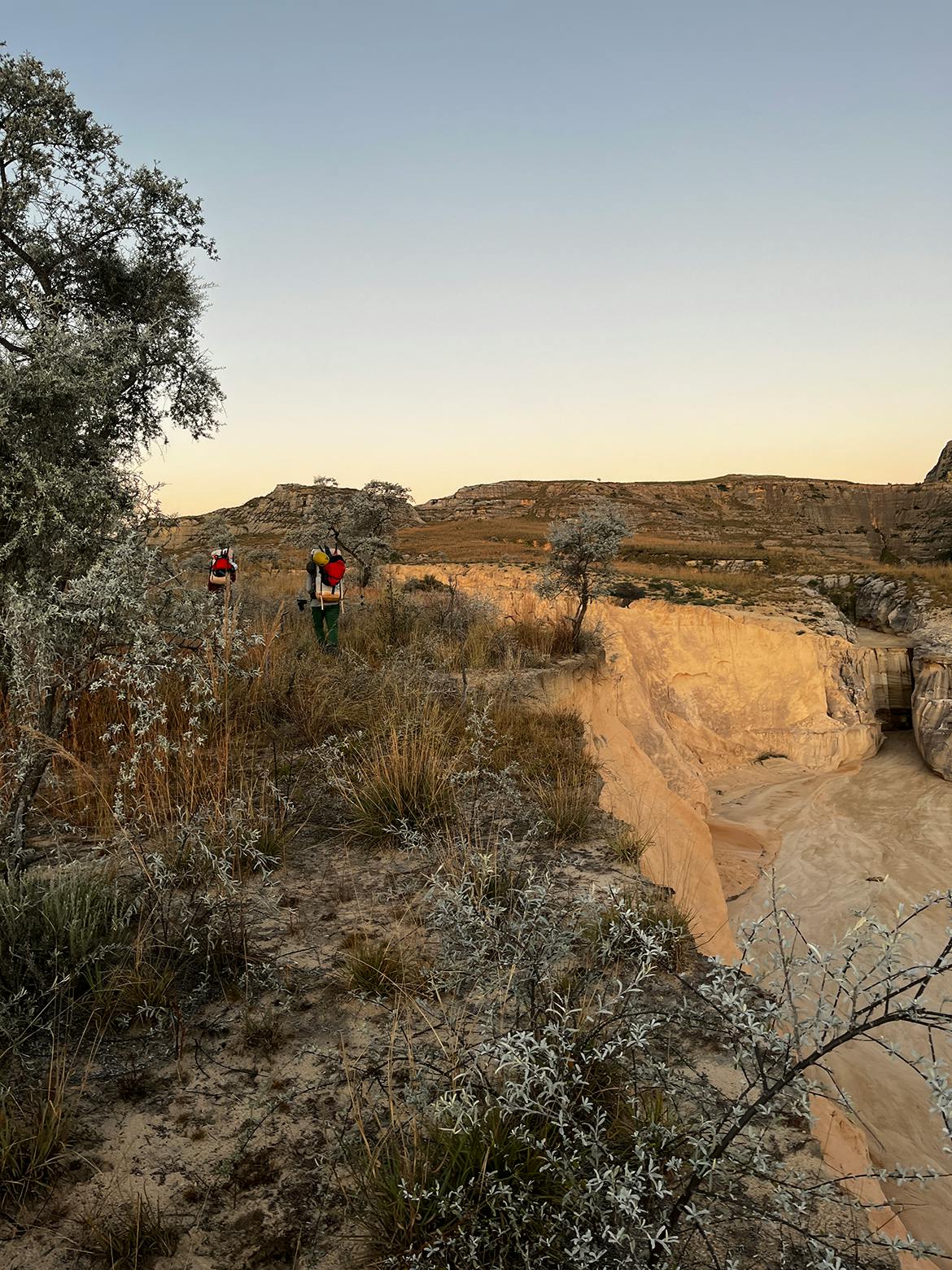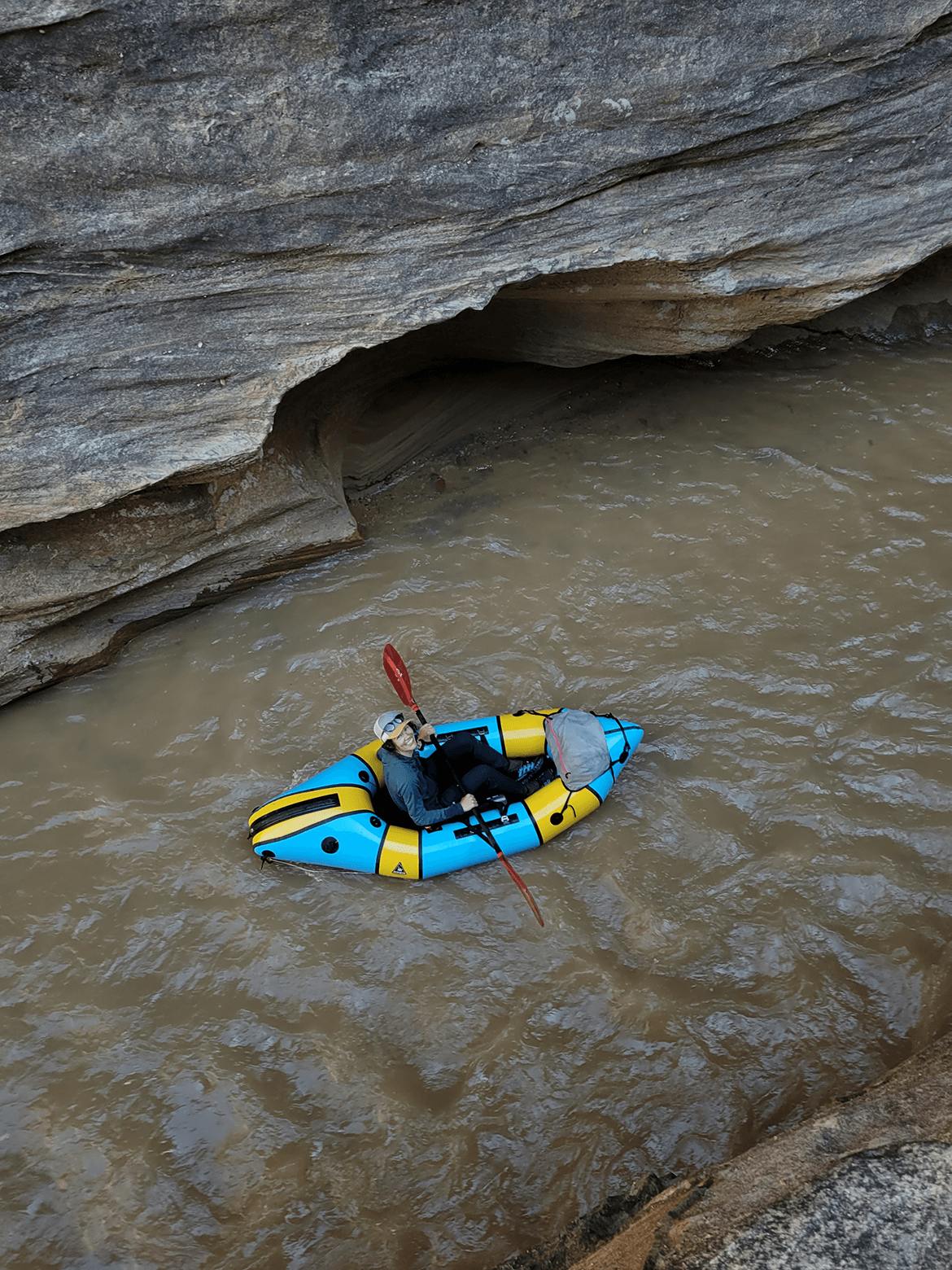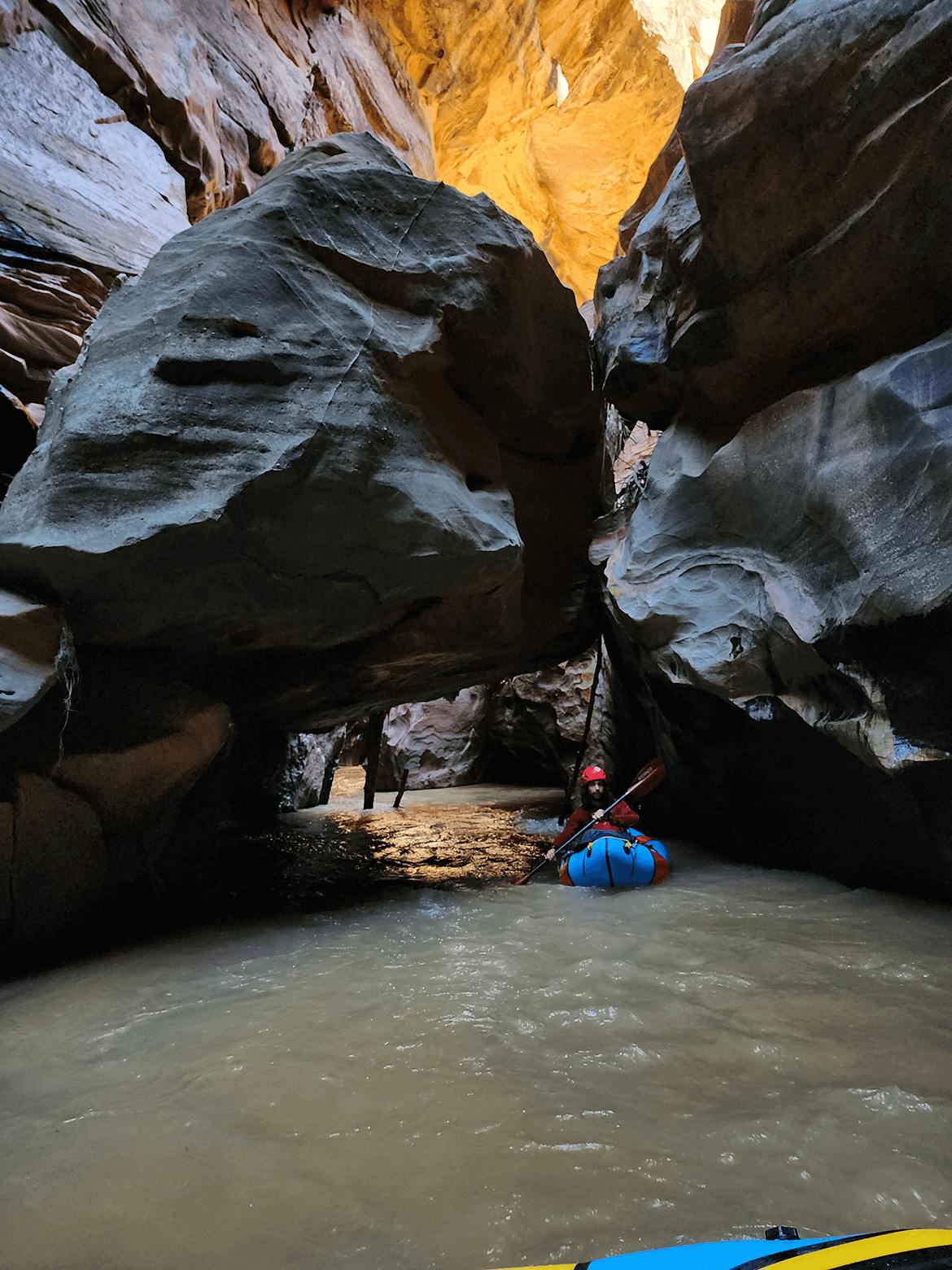The Slot: Traversing Canyons & Mountains in Madagascar
Story By:
Ben Orkin & Rives Jacaruso
Photos By:
Ben Orkin, Rives Jacaruso, & Sam Orkin
Ben had spent considerable time scouring satellite imagery of the country he’d grown mildly obsessed with, assessing topography and areas seemingly devoid of human presence promising wild beauty. Plotting routes through an area dotted with huge massifs and escarpments was a daunting task, but with the discovery of topo maps created in the mid-1900s hiding away in the archives in downtown Antananarivo, we pieced together a route that would grant us hard-earned access to a first descent we simply refer to as ‘The Slot’. Based on a combination of those old topo maps and blurry satellite imagery, The Slot appeared to be a about 43 miles long, 800 feet deep, only a few yards wide in places, and in the middle of nowhere. It also appeared likely deep enough to float our packrafts.
As formidable a challenge as The Slot appeared, just getting there would prove extremely difficult. After flying halfway around the world, driving for 3 days, packrafting 23 miles down a nearby river, and backpacking 16 miles across a maze of desert canyons, we would have to hope that there would be enough water to float.
Our plans derailed almost immediately when Air France lost a crucial bag for four days. To kill time, we visited famous Antananarivo markets, a crocodile farm and a zoo, and tasted local cuisine. Once the bag arrived, we attempted a ‘hurried’ drive to the put in, dodging oxcarts, mopeds, and potholes. Our average speed was less than 30 miles an hour, which provided plenty of time to take in the sights out the windows and generally enough time to dodge whatever might be in the road at that current moment. Mid-morning of the third driving day, we piled out of the dusty Land Cruiser at a village sitting just above the first river. Undeterred by the ridiculously low water levels, we packed our boats on our backs and hoofed downstream, accompanied by a crowd of curious villagers.
We slugged our way through braided river channels consisting of a fine, muddy sand. Small scale gem mining activity rendered the water a brownish orange. To watch the river’s makeup unfold and grow larger from small tributaries entering on either side was intriguing.

Eventually, we took the boats off our backs and inflated them, towing them through the ankle-deep water. The crowds of curious villagers continued to follow, and we waved and greeted the onlookers with “Salama” – the universal salutation in Madagascar.
Hours later, perhaps out of desperation or a strong desire to packraft as much as possible, Ben plopped down in the brightly colored boat….and.…he was actually floating! We held our breath, envious of any forward progress. Not to be outdone, we got our butts down in our boats just in time to see him stuck on the river’s shallow bottom. He shot up quickly to protect the floor from the inevitable abuse it would incur over the next 11 days. That afternoon, we all perfected the art of the “Mada Burpee”: the transition from towing boats through ankle deep water, belly flopping on or dropping into the boat as soon as the water appeared slightly deeper, starfishing our bodies as far across the boats as possible to distribute our weight more evenly, and then jumping back up when we would inevitably grind ashore moments later.


We went to bed hoping the water level would continue to deepen and our speed wouldn’t be impeded by the endless Mada Burpees. Over the next two days, we ‘paddled’ as best we could through an incredible canyon, narrowing and widening with sandstone walls etched with the intricacy of eons as our butts became more comfortable bumping along the sand. We explored a few side canyons: true riparian wonderlands laden with moss and ferns. The water revealed a clear cerulean tone in its undisturbed state (a striking contrast to the effects of even small-scale gem mining). Back on the river, wood stakes holding thatch and branches served as dams created by the miners. They forced precarious portages over the unstable, sharp structures. Just as the Mada Burpees subsided and the paddling was getting really good, we arrived at our exit tributary. From here, we would begin a 16-mile traverse across an area riddled with cliffs, ravines, and dense vegetation with no known or reliable routes (or water sources) on our way to The Slot.


Surprisingly, a small group of villagers greeted us as we dragged our packrafts upstream through our exit tributary. Even if it was impossible to communicate our destination to them, where we had come from, or the purpose of our trip, our new friends were eager to help whichever way we were heading and grabbed our packs to help. Even without our heavy packs on our backs, we struggled to keep up with our amazing barefoot guides. As the sun sank in the sky, we made camp in a dry riverbed, off the main trail. The locals hurried back to their village and wished us luck on our journey ahead. After a nighttime trip back to our exit tributary to fill as much water as we could carry across the desert (12 liters each), we fell asleep for the first time without the river to blot out any snoring.
Despite advice from the locals, we were determined to try our planned route through the dry river bed and up through a slot canyon. The locals insisted we stick to the trail but based on our maps and a lot of pointing, it appeared that trail veered farther south than we needed to go. We began before daybreak and unsurprisingly, soon met an impassable rock fall and were forced to backtrack to the place the locals had told us about. The path snaked south and then turned north, back into the dry river bed, but above the impassible slot canyon. At sunrise three villagers caught up to us and joined for part of our trek. We made our way up hills and back into drainages, up densely jungled dry canyon beds and across fields of grass taller than corn. We made good progress and rested often in whatever shade we could find. We delighted in picking snacks from wild guava trees and briefly spotted ringtail lemurs. At the hottest point of the day, we said goodbye to our new friends as they made their way back home. After napping in meager shade overlooking a Jurassic landscape, we pressed on, finding camp just above our next challenge: a steep descent to the The Slot. We were treated to an epic panoramic sunset, something we’d been missing within the confines of the first narrow river.


We started off before dawn again to make miles during the cool part of the day and conserve our limited water supply. The scraggly jungle began to thicken around us as the ridge line we intended to follow to flatter ground narrowed to barely three feet wide. As progress on the ridge became impossible, we were forced to rappel off one side into a deep ravine. Progress in the ravine was even worse than on the ridge, and we opted to hoist and hack ourselves back up the other side to the north. Once out of the ravine, we quickly found ourselves traipsing through low sedges and open rolling hills - easy walking down to The Slot. Our hopes were soon crushed as The Slot was completely dry with no sign of water. Dreams of packrafting The Slot were replaced with legitimate concerns regarding the complete lack of water sources. After the realization that we did not have enough water to back track to the first river, we walked ‘downstream’ hoping we could find enough drinking water to sustain us for the next 43 miles. Shortly after, a small spring burbled from the dry sand and we all breathed sighs of relief. Even if we couldn’t packraft, we could at least make it to our planned take out.

Just downstream a 30-foot waterfall offered another level of commitment: once we pulled the rope after the rappel, we would have to navigate the remainder of The Slot. We committed without hesitation, eager to explore the slot lined with intense purple, red and orange rock layers just downstream. Progress was often interrupted by a rather comical challenge: quicksand. The person in the lead would abruptly sink knee or hip deep and become immobile. Rescue often required the assistance of several other team members.
Much to our surprise, footpaths and evidence of more local gem miners appeared along the banks. Foreign demand had forced the gem rush to one of Madagascar’s most remote corners, and now the narrow river was filled with locals hell-bent on seeking to purge the canyon of its blue and pink sapphires. The environmental effects of even small-scale mining efforts were dramatic and our wilderness experience was interrupted by a series of mining ‘outposts’ strung along the river. While it was hard to say who was more surprised by the other (us or the miners), it was obvious that the miners were way more content. While they spent their days sifting through the sand and gravel, singing and laughing, hoping to strike it rich, we were spending our days trudging through the same riverbed, dodging quicksand, and cursing the low water levels and heavy packs. The miners spent their nights either in tiny thatched huts constructed on sandy terraces above the river, or more commonly, semi-permanent structures accessed by steps etched into the canyon’s cliffs. We spent our nights huddled by a fire cooking dinner, before retiring to bed in our lightweight shelters lined with mosquito netting. Often, our two worlds would briefly merge as the gem miners visited our camps. Smiles, laughter, and adding wood to the fire is a universal language.

With two thirds of The Slot remaining and masochistic longing for the Mada Burpees we had experienced on the first river, we decided we were tired of walking through the quicksand and that the only thing that could make The Slot more magical would be to float through it. The Slot initially proved to be the perfect playground for the second round of Mada Burpees, but gradually grew in both depth and beauty. Contoured sandstone walls rose 800 to 1,000 vertical feet straight from the river’s edge, which was now mostly floatable. The Slot varied between 50 feet wide to packraft width. As we made our way through the striated canyon, we marveled at the endemic plants and spiders lining the walls.
These narrow sections were as committing as any river we’d been on. Scouting downstream for rapids, logs, and miners and their dams was impossible. Portaging was not an option. We took the river as it came, careening down the narrow slots like pinballs mile after mile. While the whitewater never exceeded Class II or II+, the magnitude of the canyon and uncertainty of what lay downstream provided more than enough adrenaline to help keep us warm in the dark, almost subterranean, slot.
One afternoon, we were spooked by the sounds of a waterfall echoing upstream. We were in one of those slots so narrow you could hardly paddle, and eddies were almost nonexistent. With no other option, we cautiously progressed downstream.

We came upon a miner’s dam choking the river. It wasn’t a waterfall. Luckily, the miners’ skepticism and fear of us strangers was short-lived and they offered us a hand in navigating the nearly 15 foot high dam. As we pushed off, laughter and cheers reverberated downstream off the walls. With only two nights left in The Slot, we found a camp that offered the ability to climb high above the river, out of the gorge. We scrambled up through scrubby sage brush and sandstone to a view of the vast jagged beauty of the mountains around us, layered with horizontal stripes of bedded rock descending into the labyrinth where we had made camp. The enormity of the complex landscape was stunning, and perhaps even more importantly, provided critical reinforcement that this tiny river was truly the only way to traverse this mountain range.



The following boulder garden portage posed the biggest challenge of the trip and was the only time the entire trip we were grateful for low water levels. We delicately portaged over the landslide forming the boulder garden. Immediately after, the canyon narrowed and was lined with sieves. Vertical walls extended straight up from the river for 40 feet or so to a narrow bench on river left. Above this bench, the walls soared hundreds of feet higher. We were locked in. Ben was able to scout 80% or so of the gorge, and again, with no portage option, Sam led the way as we sequenced ourselves underneath boulders stuck in the canyon above us and through narrow technical drops. The final obstacle was a 15-foot high boulder lodged directly in the river’s path. With no way around, we were forced to climb the boulder and then rope our fully inflated packrafts up and back down.




And then, just like that, it was over.
Almost as abruptly as the river had narrowed, it spit us back out into the open plains. As the river widened it grew shallower, tall grasses lined the banks, and round three of the Mada Burpees started. Local villagers gathered and joined us on the seemingly endless downstream march. After farmers warned that our final camp was surrounded by crocodiles and then proceeded to gift us a dead a snake, we ate dinner watched by several curious onlookers and shared leftovers. The next day we towed the packrafts the final six miles to the takeout and back to civilization, shocked by the sudden transition from The Slot, to village life, to an air conditioned car.
After making a quick detour to scout another slot canyon that looked promising from satellite images, the three-day drive back to Tana seemed to fly by as we knew we’d be back to this wonderful country.

